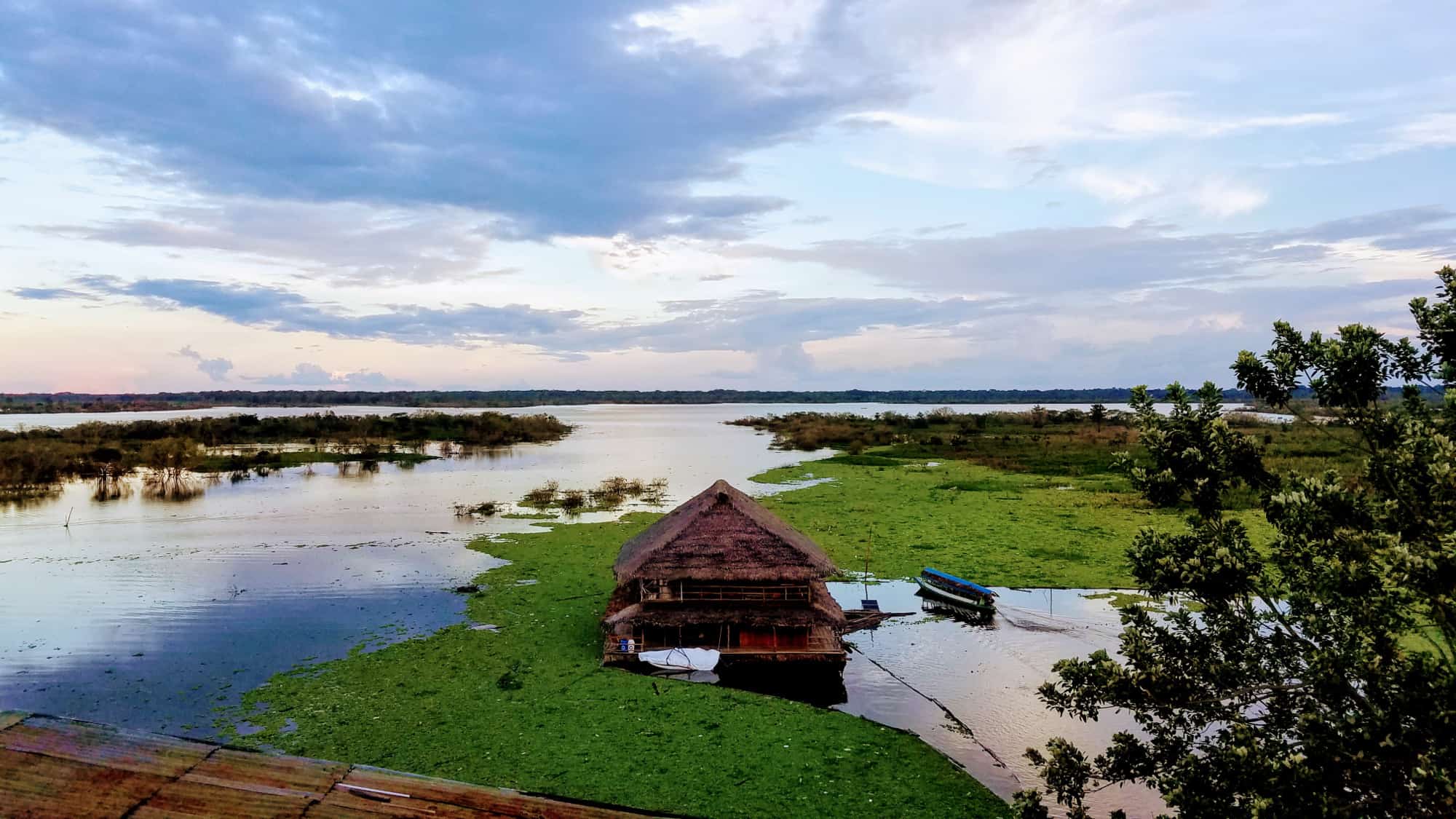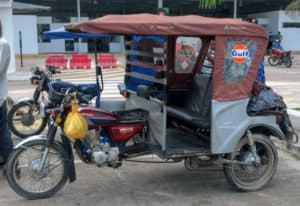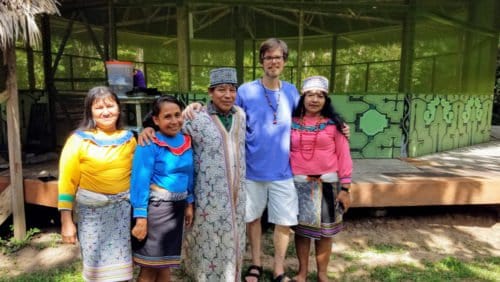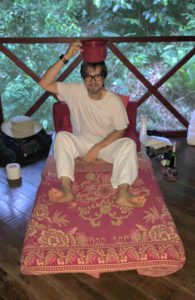If you’ve heard of Ayahuasca, you likely connect it with the Peruvian Amazon and Rainforest. It’s no surprise since Ayahuasca (iowaska, or yagé), is an entheogenic brew made out of Banisteriopsis caapi vine and other ingredients and is often used as a spiritual medicine in many ceremonies in the Amazon. If I was going to have a deep immersion with Ayahuasca, Peru was where I needed to head.
My Ayahuasca Experience in Peru
The encroaching vegetation at the edges of the tarmac became visible as the plane landed. Iquitos, Peru existed tenuously, as an island in the jungle, always on the brink of deluge and immersion. There are no roads to Iquitos. The only way to this island is by a days-long journey by boat, or by airplane.
Our plane taxied into the berth and the crew broke the seal of the door. The humid living air of the Amazon rainforest immediately replaced the synthetic climate-controlled air in the cabin. We all breathed in Iquitos; our own immersion into the world of ayahuasca and plant medicines was imminent.

The Edge of Iquitos. Photo by Strobus.
Arrival
In the terminal, our baggage flowed onto the conveyor belt while hotel shuttle drivers rounded up their passengers. Languages were negotiated, arrangements improvised. The hotel shuttle driver liberated us of our luggage and escorted us to the exit.
We spilled out into the parking lot where we were greeted by a buzzing swarm of tuk-tuk drivers. Tuk-tuks are the colloquial name for the auto rickshaws that function as taxis in Iquitos. The front looks like a motorcycle and the rear like a horse-drawn carriage seat with a canopy over it. The thick, humid air clattered with the din of two-stroke engines. The porter eagerly transferred the luggage into the shuttle, and then held out his hand, stating without question, “tip.”

Tuk-Tuk, auto rickshaw taxi. Photoby Strobus.
The outsized shuttle rolled carefully down Avenue Abelardo Quiñones toward the city center while fragile tuk-tuks buzzed around on all sides, passengers leaning out of the backs holding their bags onto the rack with white knuckles and straining arms.
We slid past row after row of shacks with rusty metal roofs and stucco walls with patchy, peeling paint. Here and there a motorcycle would peel away from the traffic flow and drive right into the open doorway of one of the buildings. There did not seem to be any doors or windows to speak of.
As we pulled up to the hotel, a crowd of vendors situated themselves to hawk their wares to the newly arrived batch of tourists.
Each clutched a bundle of jungle essentials, hats, sunglasses, fans, and also crafts like handmade necklaces, to which they gestured and said “ayahuasca” in a reverent and suggestive way. If you’re a Northerner in Iquitos, everyone knows immediately that you’re either on your way to an ayahuasca journey or just returning from one.
The Market
After checking in to the hotel, I met up with a friend and we headed by tuk-tuk over to the big market across town, the Mercado de Belén. I was in search of a ceremonial pipe and some mapacho to put in it. Mapacho, the native wild tobacco, Nicotiana rustica, is revered in the Amazon as a master plant-teacher and a most trusted ally. It is a must-have companion for an ayahuasca journey.

On ‘mapacho’ street at Mercado de Belén. Photo by Strobus.
The market was a colorful cacophony of every conceivable item for everyday living stuffed into open-air stalls constructed over the sidewalks and streets. Each street featured products of a similar kind.
We disembarked our tuk-tuk on ’souvenir’ street, and our tuk-tuk driver, who seemed eager to give us a more guided experience, escorted into the depths of the crowds and noise towards ‘clothing’ street.

Medicines at the Shamans’ Market. Photo by Strobus.
My friend purchased rubber boots for our trek the next day into the jungle. Then we proceeded past ‘meat’ street to the ‘shamans market’, where I knew I would find what I was looking for.
The shamans market was a feast for the senses and the perceptions. Immediately upon turning the corner I was enchanted by the fresh floral and herbal scents of the jungle. Strong medicinal breezes wafted through me, flirting with my lungs, blood, and brain, coloring my perceptions and intoxicating my spirit.
I floated in my vegetal daydream over to a stall displaying a number of hand-carved mapacho pipes. My friend, who had a degree in Spanish, helped me to navigate the purchase of a pipe carved in the shape of a tobacco leaf. I got a small bag of mapacho to go with it. We wandered a bit more in the market, then walked across town back to the hotel.
Diving In
The next morning 24 of us boarded a bus and headed to the outskirts of town. We arrived at a dock on the Nanay river, a tributary to the Amazon, and stepped off the bus into the humid air and sunlight. The bus would be the last climate-controlled environment we would be in for the next three weeks.
We were met at the dock by a crew of Shipibo villagers who worked with our retreat center, The Temple of the Way of Light. The Shipibo are one of a number of peoples native to the Peruvian Amazon. They are well known in Peru and worldwide as masters of plant medicines, Ayahuasca and vegetalismo shamanism. Over the next three weeks, we would come to experience their powers firsthand.
The workers transferred our luggage over to a wooden boat with a thatched roof waiting at the dock, and the 24 of us boarded a second boat. We navigated up the river for about half an hour. We then turned into some backwater channels, losing sight of the horizon once and for all. We crept deeper and deeper into the jungle past forks and sharp turns around densely-grown bends in the channel. This was a labyrinth. We would not have been able to find our way back if we had tried. Our Shipibo navigators knew the way without hesitation, and without GPS.
After another 30 minutes navigating the backwater channels, we arrived at our destination, another dock along a wide path that stretched still deeper into the jungle. The entire Shipibo village, it seemed, had turned out for our arrival. Each villager hoisted two or three bags onto their backs, shoulders, and heads, and headed down the path toward the retreat center, moving at twice the speed of us guests, even though heavily laden.
Vomitivo
Upon arrival at The Temple of the Way of Light, we were summoned to the Casa de los Maestros. Four-by-four we drank a bucket of lemongrass tea and then forced ourselves to follow that with bucket after bucket of warm water.
The epic vomiting that ensued provoked cheers of support and laughter from the rest of the group. The purpose of the ritual was to purge toxins from our bodies and prepare us for the Ayahuasca, but it turns out that group vomiting is also a great ice breaker and bonding exercise.

Casa de los Maestros. Photo by Strobus.
Ayahuasca Immersion
Our ayahuasca ceremonies at Temple were held in one of their three malokas. We assembled at dusk to set up our mats, speak our intentions, and settle in with a guided yin yoga practice. Night fell, and the sounds of cicadas, frogs, owls, and monkeys washed over us like a gently flowing and chuckling brook. The ceremony facilitator and the Maestros arrived, merging quietly into our flow. They prepared themselves and the maloka with mapacho, and the medicine with a softly whistled icaro. Then it was time to drink.
The walk from my mat to the Maestros in the center of the maloka to receive ayahuasca was like walking up to the edge of a cliff. I sat down in front of the Maestra next to the facilitator, and after a brief consultation on dosage, the drink was poured and handed to me. Every time I drink ayahuasca I reach a moment of reckoning as I hold the cup. Am I really doing this, again? Then I think of the benefits and gifts I have received, and I recover my resolve. I called to mind my intentions and whistled them softly into the cup. Then, without further equivocation, I downed it in one wretched tasting gulp.
For the next forty-five minutes, the medicine argued with my stomach about whether it should stay down or be expelled. The mareacion, the effect of the medicine, overtook my entire body and my mind. There were no visions yet, no psychedelic mind palaces, just a heavy, nauseated feeling.
The opening icaros of the Maestros cut through the quiet, anchoring my listing body and centering my mind. Then the dark air in front of me began to light up with waves and patterns, subtly at first, then gaining in power until they consumed every corner of my conscious awareness and every sensation from my body.
Immersive scenes from my memory or my imagination played out on occasion in dreamlike sequences. Sometimes I found myself in a geometrical lattice of infinite dimensions, with each dimension having infine jeweled facets all waving and snaking and folding endlessly into themselves. In this, I was not a passive consumer, such as of a screen saver on a computer screen. Every aspect of the scene was me, was my awareness, and there was no distance in between.

Strobus with Maestros Manuela, Tanya, Damian, and Olga. Photo by Strobus.
The Maestros made their way around the maloka to sing a personal icaro to each person.
The songs were otherworldly. Icaros are channeled directly from the plant spirit world, and they are specifically and intentionally aligned with the medicine of those plants for the purpose of healing the specific ailments of the person they are sung to. In the Shipibo tradition, they are one-of-a-kind intuitive creations.
As the Maestros sang to me I could feel the effects of the medicine kicking into high gear. I swayed back and forth, hanging on every staccato note and drinking in the ever-unfolding melody. Their songs were brilliant, and the work they were doing with these plant spirits on my body and mind was pure wizardry.
I felt the ayahuasca plumbing the depths of my intentions, searching for the key to unlock my healing. This was a spectator sport. It required no direction from me other than the intentions I had set at the beginning of the ceremony.
When the medicine found the spot, my vision darkened and a most intense nausea overtook me. I relaxed and let it build past the point of discomfort and into submission to whatever lesson was there for me to learn. Visions of my sickness roiled through my brain. Like a depth charge into my nauseated intestines, there was a final intensification of the medicine’s penetration. Then I vomited forcefully and at length into my purge bucket.

Strobus with Purge Bucket. Photo by Mimi Wiggins.
Words cannot express the profundity of the healing power from ayahuasca. The vomiting is not merely a physical activity. It is a psychological act. The medicine somehow finds exactly what needs to be cleared to either realize your intentions or to address blockages to doing so. Then it causes you to expel that from the mind and psyche in vomiting.
Purges can also happen through defecation, crying, yawning, shaking, laughing, sweating, and probably any number of other ways the body expels excess or unwanted energy.
After I purged, I felt holistic waves of a most pure and complete bliss. My body, breath, and mind felt clear and free, simultaneously connected to the cosmos and grounded to creaturely existence on Earth.
The feeling seemed to extend beyond my body into the maloka and out into the surrounding jungle. I became aware of place again, and my surroundings were rapt in calm, clear celebration of the miracle that had just occurred. I rested, listening to the symphony of jungle sounds outside and to the continued work of the Maestros and my fellow pasajeros in the maloka.
Temple of the Way of Light
The Temple of the Way of Light’s deep immersion program with Ayahuasca is more than just a series of ayahuasca ceremonies over a span of three weeks. It was a comprehensive, integrated program that addressed all aspects of being. Each day featured a few workshops or talks that addressed some aspect of the body or mind, and the subject matter was brilliantly crafted to follow the unfolding medicine and healing journey that took place over the course of the retreat.
There were yoga classes for the body, qigong classes for the energy system, self-inquiry exercises to locate and stir up issues to be worked on, and individual consultations to provide compassionate, one-on-one assistance. The crown jewel of the program, though, was the mindfulness training. This went well beyond just guided meditation. It provided practical techniques for realizing the nature of mind and its inherent fallacies and traps.
The skills taught in these sessions were crucial for helping to make sense of the ayahuasca experience and to deal effectively with the content it stirred up. The mindfulness sessions, especially, followed a story arch through the three week retreat, providing the precise tools needed at the right time as our healing work developed over the course of seven ayahuasca ceremonies.
The Temple of the Way of Light’s deep immersion program sets the gold standard for ayahuasca retreats. While there are many retreat centers doing wonderful work with integration practices such as yoga and meditation, I have not heard of or read about any program more comprehensive and well crafted than this one.
Beyond helping pasajeros effectively integrate their ayahuasca experience, they are, in a sense, integrating the ayahuasca experience with common wellness practices used in the rest of the world. It’s hard to overstate the value of this, not just for all the people that can be helped by such an integrated approach, but also for placing ayahuasca healing in context with other healing traditions found throughout the world. This will help shift attitudes and raise awareness of the incredible healing potential of psychedelics.
Home Again
I’ve been home in Boston for a few weeks now, and the icaros of the Maestros are still echoing in my mind. I hope to return to the Temple of the Way of Light someday, or to see some of the staff or my fellow pasajeros in other contexts. There is no question that my experience in the jungle was deeply healing and pivotal. I look forward to engaging this better version of myself in service to my family, community, and the world we live in.
Have you had an experience with Ayahuasca in Peru, other parts of the Amazon or elsewhere? What was your experience like. Feel free to share in the comments below.
Other Articles You May Enjoy
- Bush Tea Medicine Woman Pours Tea in the Bahamas
- Getting an Education in Bush Medicine in South Africa
- 5 Useful Books on Shamanism
- Martial Arts, Enlightenment and the Quiet Mind
- Connecting to Spirit Medicine is Connecting to Ourselves
- Peru: An Experience with Ayahuasca Wasi
- Heal Through a Spiritual Sangoma
- Heart and Embodiment meets Heart & Consciousness

Strobus is a technologist for wellness and a practitioner of vegetalismo shamanism. He is currently architecting a healthier, distraction-free web and social media paradigm, as well as holding practice in the Shipibo vegetalismo tradition. He resides in Massachusetts with his wife and three teenaged sons.








